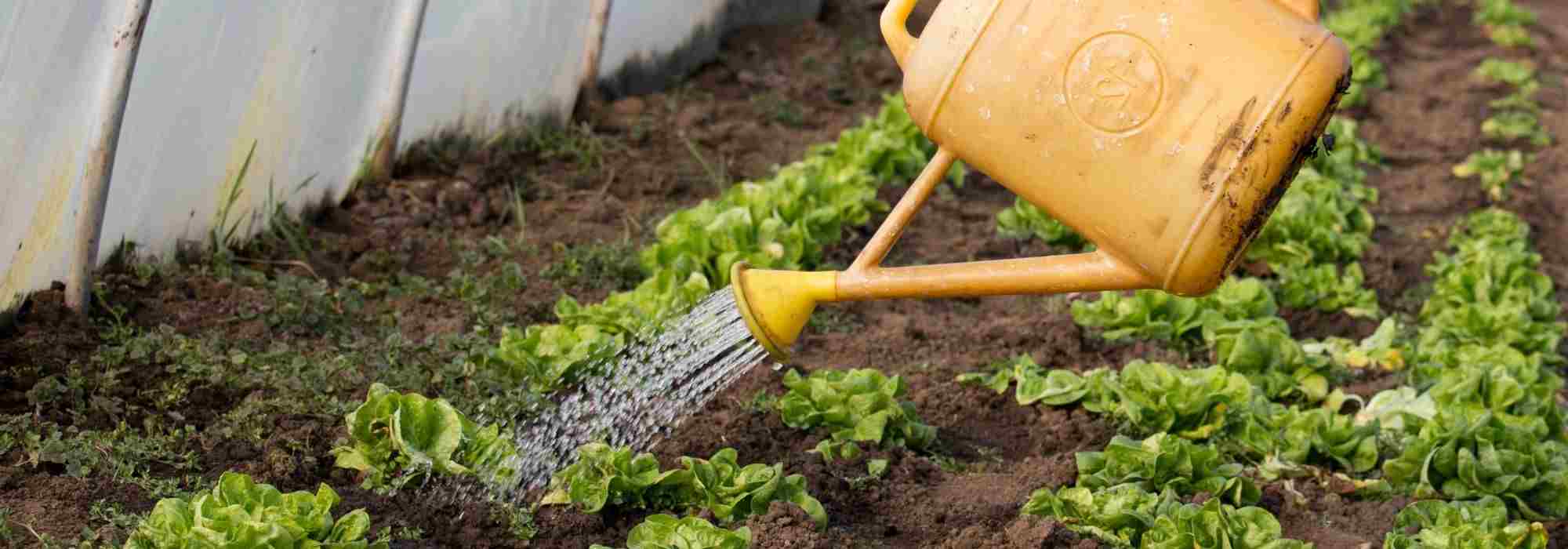
How to manage watering in a greenhouse?
Our tips to water crops properly
Contents
To achieve beautiful crops in a greenhouse, managing watering is one of the fundamental points.
In these enclosed spaces, plants are generally isolated from any precipitation. Additionally, temperatures tend to rise quickly, especially in the summer season, leading to water evaporation, soil drying, and crop stress.
Among the many irrigation systems available for garden greenhouses, it is essential to choose one that meets the needs of the crops as well as the comfort of the gardener.
Here are our tips for effective watering in a greenhouse, from selecting the type of irrigation to natural methods for reducing evaporation.
What type of water to use in a greenhouse?
Rainwater
Cost-effective and eco-friendly, rainwater is ideal for watering crops in greenhouses.
However, depending on the region and the season, it is not always possible to benefit from water from the sky all year round.
The best solution is to have a storage system, which allows you to collect rainwater in a tank, barrel, or water collector connected to the gutters.
If you are fortunate enough to have a well, you can certainly use the water for watering sowings, potted plants, vegetables, and other fruit trees, while ensuring it reaches room temperature to avoid thermal shock.
Tap water
Tap water has the advantage of being accessible and always available. However, watering a greenhouse exclusively with mains water can ultimately represent a significant financial expense. This less economical and eco-friendly solution should therefore be reserved, if possible, for periods when rainwater is not available.
Moreover, tap water can sometimes be too chlorinated and hard for plants. For particularly sensitive crops, you can use a scale inhibitor to dilute in watering water.
Plan for a water tank
To store water, you can either install a tank directly in the greenhouse or outside.
Installing a fixed water reservoir under the garden greenhouse has many advantages:
- accessibility
- water at ambient temperature
- increased humidity levels within the greenhouse
This reservoir can take the classic form of a barrel, but it can also be a dug pond, constructed with waterproof reclaimed materials, or even recycled, for example, by repurposing an old bathtub covered with a mosquito net.
The water tank can be connected to a gravity-fed irrigation system without electricity if it is placed at a height. This way, watering will be naturally carried out by gravity.
If the water is stored outside, it is quite possible to install a pump to irrigate the water into the greenhouse. In this case, prefer a tank placed in the shade, so that the water remains at an acceptable temperature even in summer, thus preventing thermal shocks during watering.
Some irrigation kits even include pumps for water reservoirs that operate on solar energy, allowing for installation anywhere in the garden without electricity.
Also consider installing a filter in your water reservoir to limit algae deposits that could eventually clog the drains.
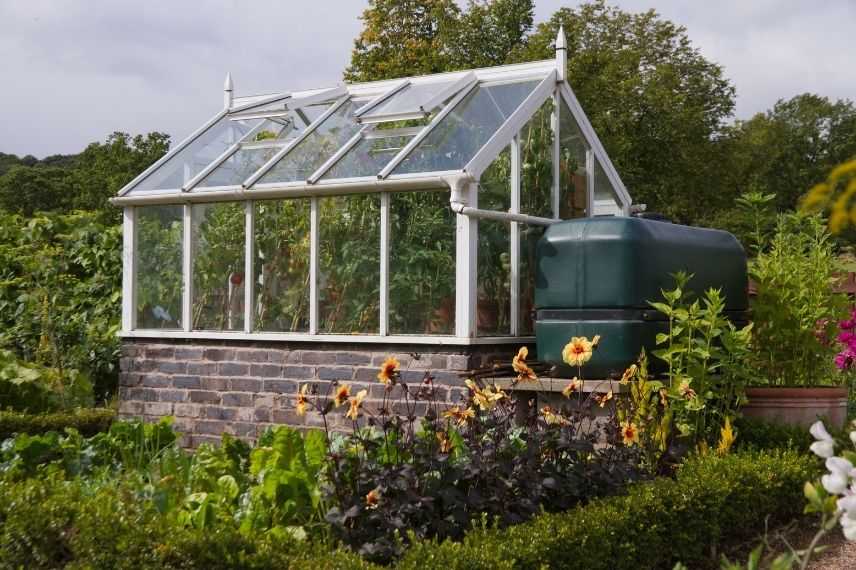
Manual watering: simple, but tedious
Manual watering can be done in 2 ways: using a watering can or a hose.
Ideally, for manual watering that meets the needs of most crops, you will need: a long-beaked watering can for precise watering, a watering can with a rose for delicate crops, accessories to control the flow of the hose, and a misting device.
The advantages:
- simple
- inexpensive
- perfect control over watering doses
The disadvantages:
- time-consuming
- fatiguing (depending on the weight of the watering can and the trips to be made)
- no watering of crops in case of absence
This type of watering is therefore reserved for small greenhouses, shaded greenhouses where the soil dries out less quickly, or young sowings.
Prefer manual watering in the morning or late in the day to limit evaporation risks and give plants enough time to hydrate.

Long-beaked watering can, watering can with rose, and hose nozzle with flow adjustment
Automatic watering: a worthwhile investment
There are many automatic watering systems to choose from, depending on budgets, the needs of the crops, and the gardener.
For gardeners who are often away, an automatic watering system combined with a timer will be essential.
Ideally, the chosen irrigation system should be set up before the year’s crops.
The pros:
- regular watering
- almost autonomous system
- when combined with a timer, watering can be scheduled during the cooler parts of the day, even at night
- water savings
- time-saving
The cons:
- more expensive
- installation needs to be considered
- winter storage of equipment
- electrical connection may be necessary (additional energy consumption to consider)
Drip irrigation
This is one of the most commonly used systems in greenhouses by individuals. Drip irrigation allows for gentle and regular watering directly at the base of the plants rather than on the foliage, thus limiting the risk of fungal diseases (such as powdery mildew, downy mildew, or rust). Drip irrigation is particularly suitable for growing tomatoes, salads, courgettes, etc.
Drip irrigation consists of polyethylene pipes laid directly on the ground. These perforated pipes allow water to flow at regular intervals or along their entire length. This irrigation system is ideal for both flower beds and pots.
Some kits also offer shut-off valves according to the watering lines and flow reducers to precisely control the water supply based on the crops.
Easy to install, it allows for targeted watering that can be adapted to all greenhouse layouts, thanks to elbow connectors and diversion fittings. Connected to the main pipe, they enable coverage of the entire area to be watered.
Note that the longer and wider the pipe, the more pressure it will need to reach all the plants at the end of the line.
Microporous Hose
Microporous hoses are flexible hoses with “pores” that allow water to seep out regularly and gently.
It is simply laid on the ground between the crops, with no special assembly required. Accessible and inexpensive, it is, however, less durable than drip irrigation. Its proximity to the soil and tiny holes tend to clog, resulting in irregular or even failing flow.
Watering is also less precise and cannot be adjusted according to the needs of each plant.
Sprinkler system
Sprinkler systems or suspended tubes are generally less used in non-professional greenhouses. They distribute water broadly over the plants from top to bottom and do not allow for precise watering.
This system is best reserved for large spaces, tropical greenhouses, or crops that require regular leaf humidification.
Adding a timer
Whether solar or electric, the timer allows for automatic watering without any intervention or almost none from the gardener. When combined with automatic watering, it ensures a 100% autonomous system.
In case of absence or at night when temperatures are particularly high: watering can be scheduled at any time, precisely choosing the desired duration and frequency.
Some models even offer a sensor that automatically triggers watering based on humidity levels, while others can be activated remotely from a smartphone.

Drip irrigation, sprinkler irrigation, and timer
Also, discover our tips: How to install an automatic watering system on a balcony or terrace?
Other irrigation systems
The capillary mat
The capillary mat is a synthetic absorbent mat that gently releases water to plants.
It is only suitable for potted plants, which will be placed directly on the mat, with their substrate in contact with the system. It proves particularly useful in the absence of the gardener.
This system allows for gradual watering by capillarity, without wetting the foliage: the plant’s substrate gradually draws water stored in the mat.
The price varies according to the size of the capillary mat. Easy to install, its lifespan is however limited, as constant moisture can lead to the development of moss or algae and deteriorate the material.
The irrigation table
Much more expensive, especially used in professional greenhouses, these growing tables, also known as tide tables or flood tables, allow for the irrigation of potted plants.
These are placed in a metal tray with a sub-irrigating bottom, allowing for watering of the substrate from below.
These systems generally have several options for the gardener’s comfort: height adjustable, movable with wheels, etc.
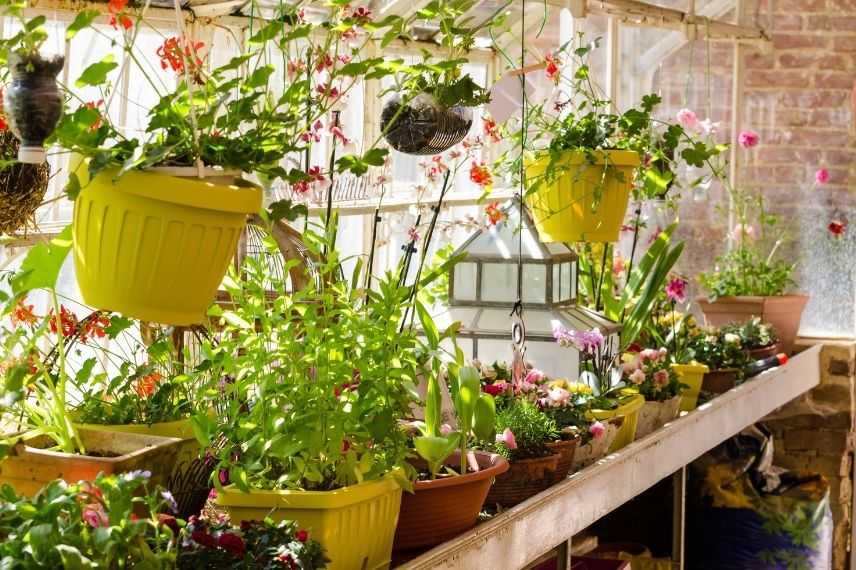
Metal table forming a tray thanks to its high edge and allowing for the irrigation of plants by capillarity.
Mulching to space out watering
In the garden as in the greenhouse, mulching is an ideal solution to space out watering.
Install an organic mulch (cardboard, straw, flax, hemp, wood chips…) in a layer of a few centimetres around the plants. This protection, in addition to maintaining a more constant soil temperature and combating the emergence of adventive plants (“weeds”), greatly limits evaporation.
Depending on the ambient temperature, mulching can thus allow for several days of watering to be saved.
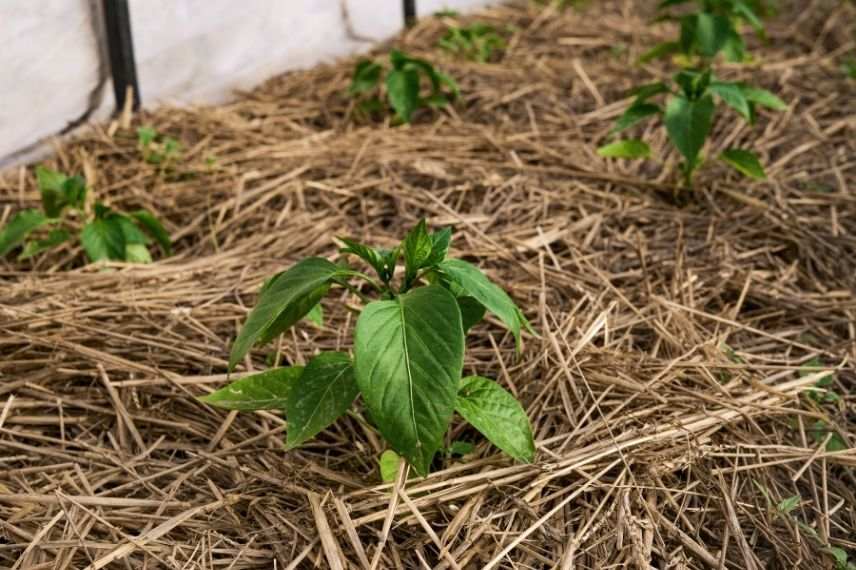
Complementary watering solutions for greenhouses
Whether you choose a manual or automatic system, you can easily add slow-release watering solutions:
- porate ceramic cones (irrigation or watering spikes), planted in the soil to gently diffuse water to the plants;
- ollas or oyas (available for purchase or easily made yourself with terracotta pots), whose porous material allows water to seep gradually near the roots of the plants;
- watering cans or plastic bottles with small holes placed at the base of the crops.
Effective, customisable, economical, and eco-friendly, these systems can be used in conjunction for optimal watering in your garden greenhouse.
- Subscribe!
- Contents
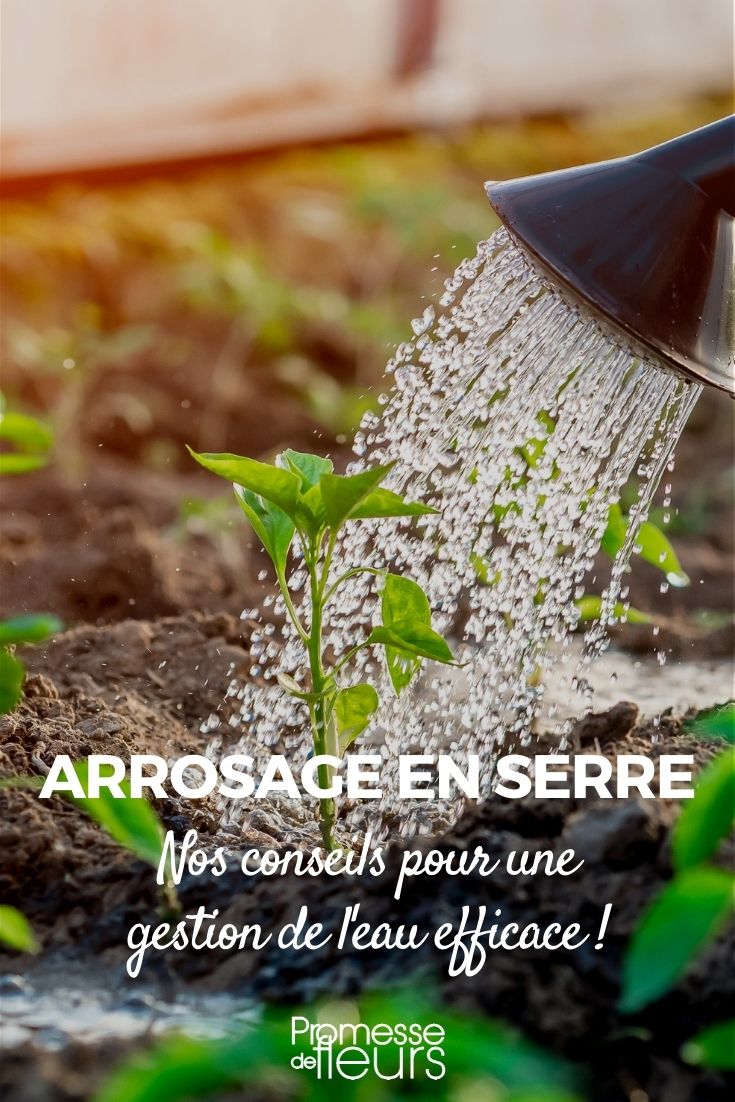































Comments